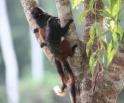Monkey business in Peru
Studying monkeys in their natural habitat is not something that everyone would want to do. For some, seeing the monkeys at the zoo is close enough. One SIUE College of Arts and Sciences professor prefers to get up ‘close and personal’ with the jungles of Peru to study her monkeys.
Jennifer Rehg, associate professor of anthropology, spent nearly seven months in the jungles of southwestern Peruvian state of Madre de Dios. Rehg was at two sites studying the monkeys–the Los Amigos Biological Station (CICRA – Centro de Investigación y Capacitación Rio Los Amigos) and the Rodal Semillero de Tahuamanu. Rehg’s time in Peru is an extension of research that she conducted a few years back in Brazil. This trip was a sabbatical research trip that allowed Rehg to travel to a field site she had been invited to by her colleague Mrinalini Watsa from Washington University.
In the seven months in Peru, Rehg observed the behavior and ecology of several types of monkeys–the callimico or Goeldi’s (Callimico goeldii), the saddle-back tamarin (Sanguinus fuscicollis), the emperor tamarin (Sanguinus imperator), and the red-chested tamarin (Sanguinus labiatus). She followed the monkeys through the jungle and collected data on food resources and habitats. Rehg stated that the callimico is the monkey that she is interested in because it’s a rare species.
As an anthropologist, Rehg is interested in monkeys and what their diet and habitat requirements are. Rehg stated that she studies how the monkeys use the forests, what kind of food resources are utilized, and what slight variations may cause the monkey so be in one habitat but not a very similar habitat. These variations may provide keys to proper conservation programs for the habitats of the monkeys according to Rehg.
“It’s an area that currently is experiencing a lot of disruption from human activities. There’s gold mining activities along the river.

A Saguinus fuscicollis monkey, a species studied by Jennifer Rehg. photo courtesy of Mrinalini Watsa.
Deforestation is increasing. So there are some interesting questions, specifically for this particular monkey about why it’s so rare and how changes to the habitats that are occurring currently might affect its population.”
The callimico monkey is particularly interesting because its numbers seem oddly low to Rehg and other anthropologists.
“It looks like its just very rare in all the places that it is found,” said Rehg. “It’s very confusing as to why its found in some places–some sites–when you go to a nearby location where it seems like there are the same habitats there and it’s not found there. There is very little understood about why it can be found in some places and not others and how that relates to its habitat preferences.”
“One other really neat thing about the three monkeys is they form what are called mixed species associations, where groups of all three species will travel together, share food resources, in some cases day after day. My research in the past has been focused on questions about why they would do that,” said Rehg. “In the research in Brazil, the majority of evidence I found really supported the idea that the monkeys are coming together perhaps as a method of predator defense. So, by ganging up in the groups, there are more eyes to watch for predator. Also perhaps they use each other to find certain resources like producing fruit trees.”
The habitats of the monkeys are being taken into consideration as Peru continues to grow. According to Rehg, a highway that was recently officially complete has allowed different groups, involved in legal and illegal activities to begin to exploit the resources that the monkeys need, including the habitat.
“I think Peru is really making its presence known in terms of being able to do research in its own country in with conservation,” said Rehg. “So, it’s in part spurred on by the conservation issues that are occurring currently.”
Rehg will give a presentation on her sabbatical research on Thursday, November 17 at 2 p.m. in the 3rd floor conference room of Lovejoy Library.
Page 1 of 3 | Next page

